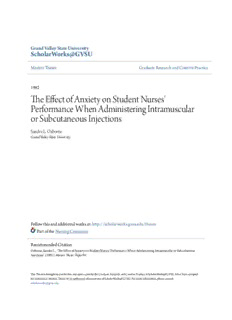
The Effect of Anxiety on Student Nurses' Performance When Administering Intramuscular or ... PDF
Preview The Effect of Anxiety on Student Nurses' Performance When Administering Intramuscular or ...
GGrraanndd VVaalllleeyy SSttaattee UUnniivveerrssiittyy SScchhoollaarrWWoorrkkss@@GGVVSSUU Masters Theses Graduate Research and Creative Practice 1992 TThhee EEffffeecctt ooff AAnnxxiieettyy oonn SSttuuddeenntt NNuurrsseess'' PPeerrffoorrmmaannccee WWhheenn AAddmmiinniisstteerriinngg IInnttrraammuussccuullaarr oorr SSuubbccuuttaanneeoouuss IInnjjeeccttiioonnss Sandra L. Osborne Grand Valley State University Follow this and additional works at: https://scholarworks.gvsu.edu/theses Part of the Nursing Commons SScchhoollaarrWWoorrkkss CCiittaattiioonn Osborne, Sandra L., "The Effect of Anxiety on Student Nurses' Performance When Administering Intramuscular or Subcutaneous Injections" (1992). Masters Theses. 96. https://scholarworks.gvsu.edu/theses/96 This Thesis is brought to you for free and open access by the Graduate Research and Creative Practice at ScholarWorks@GVSU. It has been accepted for inclusion in Masters Theses by an authorized administrator of ScholarWorks@GVSU. For more information, please contact [email protected]. THE EFFECT OF ANXIETY ON STUDENT NURSES' PERFORMANCE WHEN ADMINISTERING INTRAMUSCULAR OR SUBCUTANEOUS INJECTIONS By Sandra L. Osborne A THESIS Submitted to Grand Valley State University in partial fulfillment of the requirements for the degree of MASTER OF SCIENCE IN NURSING Kirkhof School of Nursing 1992 Thesis Committee Members Emily Droste-Bielak, R.N., Ph.D. Donna Larson, R.N., Ph.D. Richard Paschke, Ph.D. ABSTRACT THE EFFECT OF ANXIETY ON STUDENT NURSES' PERFORMANCE WHEN ADMINISTERING INTRAMUSCULAR OR SUBCUTANEOUS INJECTIONS By Sandra L. Osborne The purpose of this study was to determine what the relationship was between levels of trait and state anxiety and performance when giving intramuscular or subcutaneous injections. It was a replication of a study by Megal, Wilken, and Volcek (1987). In May, 1990, the STAI Form Y-2 was used to assess trait anxiety of 17 students at a community college in the Midwest. State anxiety was measured by using the STAI Form Y-1 immediately before: 1) laboratory performance examinations and 2) giving first injections to clients. Instructors completed Injection Skill Check Lists to measure performance. Students reported high levels of anxiety. No significant relationships were found between anxiety and: 1) performance scores, 2) age, or 3) length of time between experiences. A significant difference between trait and state anxiety scores was found. No significant difference between instructors and state anxiety scores or performance scores were revealed. ii This is dedicated to all nurse educators who facilitate the teaching-learning process by treating each student as an individual with unique learning needs. Ill Acknowledgements I want to thank the chairperson of my committee. Dr. Emily Droste-Bielak, R.N., Ph.D. who spent many hours critiquing my endeavors and guiding me throughout the research process. Appreciation is also extended to Dr. Donna Larson, R.N. Ph.D. and Dr. Richard Paschke, Ph.D. who willingly shared their time and expertise with me. Throughout this lengthy experience, several collègues, friends, and family members have been supportive along the way. It seemed that whenever I began to falter, there was always someone to give a little push and get me back on track. Finally, my deepest appreciation is extended to my husband, Ozzie, and children, Joshua, Jeffrey, Joseph, Jennifer, and Julia, who never lost faith in my ability to complete this project. A very special thank-you to Joshua, who climbed out of bed many nights to assist me with the computer and to Ozzie, who encouraged me throughout this endeavor. IV Table of Contents List of Tables.......................................... vii List of Appendices......................................viii CHAPTER 1 INTRODUCTION.......................................1 2 LITERATURE AND CONCEPTUAL FRAMEWORK..............4 Review of Literature..........................4 Conceptual Framework ..................... 10 Research Questions...........................17 Definitions...................................18 3 METHODOLOGY............ 20 Design........................................20 Setting.......................................21 Sample........................................23 Instruments.................................. 24 Procedure.................................... 27 4 RESULTS.......................................... 31 Data Analysis................................ 31 Characteristics of the Subjects.............33 Research Question One....................... 33 Research Question Two....................... 34 Research Question Three.....................35 Research Question Four...................... 35 Research Question Five...................... 35 Research Question Six....................... 37 Research Question Seven.....................38 Other Findings............................... 38 5 DISCUSSION/LIMITATIONS/IMPLICATIONS.............. 44 Discussion........ 44 Limitations.................................. 53 Implications/Recommendations/Conclusion 56 References ............................................. 74 VI List of Tables Table 1 - Correlations Between Anxiety and Performance Scores..............................34 Table 2 - Paired T-Test Analysis of Trait and State Anxiety Scores................... 36 Table 3 - Analysis of Variance Between State Anxiety and Instructor......................... 37 Table 4 - Instructor, Route, and Medication Percentages.....................................39 Table 5 - Comparison of Medication Route with State Anxiety and Performance Scores..........40 Table 6 - Item Analysis of Incorrect or Omitted Behaviors...............................42 Table 7 - Analysis of Variance Between Performance Scores and Instructor.......................... 43 VI1 List of Appendices Appendix A - Injection Skill Check List..................59 Appendix B - Verbatim Instructions................ 62 Appendix C - Approval Form............ 66 Appendix D - Injection Skill Check Lists Results........ 68 Appendix E - Present Study State Anxiety and Performance Scores Compared with the Findings of Megal, Wilken, & Volcek (1987)................................ 69 Appendix F - Performance Errors from Present Study and Study by Megal, Wilken, & Volcek 1987)......................................... 70 Appendix G - Correlations of State Anxiety and Performance Scores from Present Study and Study by Megal, Wilken, & Volcek (1987)........................................ 72 Appendix H - Correlations of Variables in the Present Study and the Study by Megal, Wilken, & Volcek (1987)...................... 73 Vila CHAPTER ONE INTRODUCTION In order for educators to prepare graduates who can perform competently as beginning practitioners, essential technical skills must be learned. Thirty-three nursing interventions were identified by the American Association of Colleges of Nursing (1986) as being essential for a graduate nurse to perform proficiently. Calculation of medication dosage and administration of medications were two of these skills. In a study by Sweeney, Regan, O'Malley, and Hedstrom (1980), 91 essential skills were identified by both nursing faculty and nursing service. Administration of an injection was one of these skills. Keiffer (1984) found that injections were rated in the top 25% of the most frequent/most important nursing skills by nurses in 16 metropolitan hospitals. Anxiety is an emotional response within a person to real or imagined threats to one's security. It may be a destructive or motivating force, and it affects one's ability to learn. Optimal learning takes place when one is mildly anxious (Campbell, 1985) and decreases in the presence of high levels of anxiety (Spielberger, 1966) .
Description: